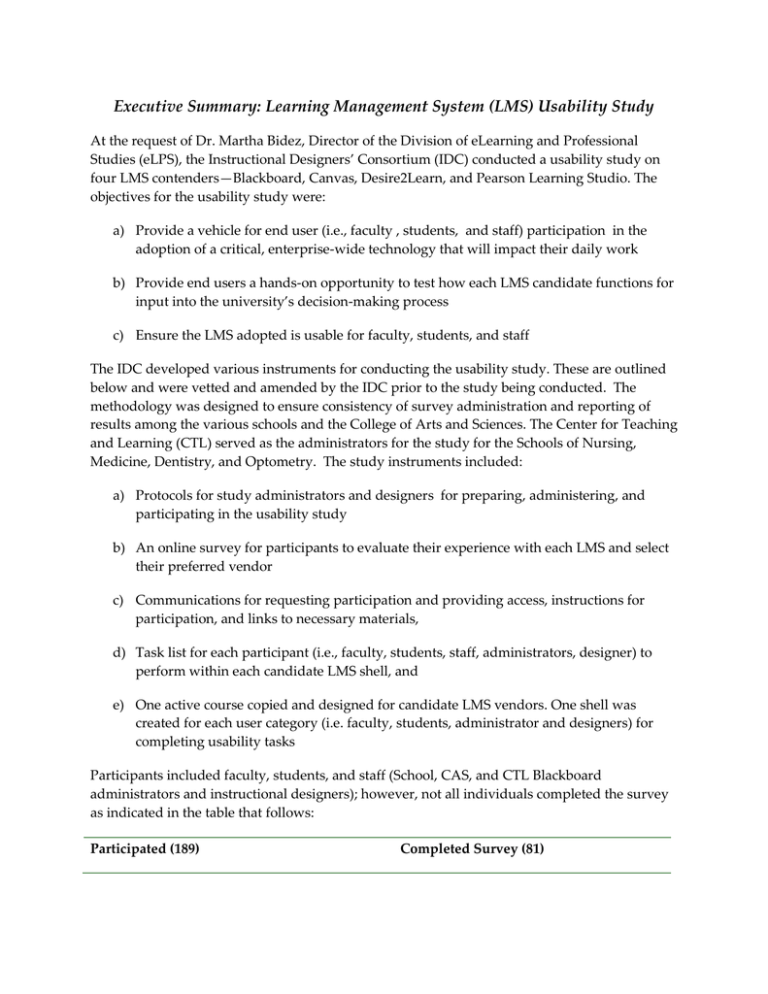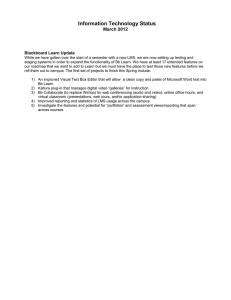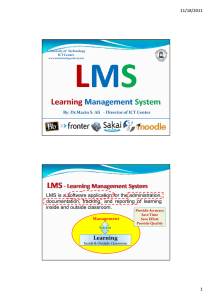Executive Summary: Learning Management System (LMS) Usability
advertisement

Executive Summary: Learning Management System (LMS) Usability Study At the request of Dr. Martha Bidez, Director of the Division of eLearning and Professional Studies (eLPS), the Instructional Designers’ Consortium (IDC) conducted a usability study on four LMS contenders—Blackboard, Canvas, Desire2Learn, and Pearson Learning Studio. The objectives for the usability study were: a) Provide a vehicle for end user (i.e., faculty , students, and staff) participation in the adoption of a critical, enterprise-wide technology that will impact their daily work b) Provide end users a hands-on opportunity to test how each LMS candidate functions for input into the university’s decision-making process c) Ensure the LMS adopted is usable for faculty, students, and staff The IDC developed various instruments for conducting the usability study. These are outlined below and were vetted and amended by the IDC prior to the study being conducted. The methodology was designed to ensure consistency of survey administration and reporting of results among the various schools and the College of Arts and Sciences. The Center for Teaching and Learning (CTL) served as the administrators for the study for the Schools of Nursing, Medicine, Dentistry, and Optometry. The study instruments included: a) Protocols for study administrators and designers for preparing, administering, and participating in the usability study b) An online survey for participants to evaluate their experience with each LMS and select their preferred vendor c) Communications for requesting participation and providing access, instructions for participation, and links to necessary materials, d) Task list for each participant (i.e., faculty, students, staff, administrators, designer) to perform within each candidate LMS shell, and e) One active course copied and designed for candidate LMS vendors. One shell was created for each user category (i.e. faculty, students, administrator and designers) for completing usability tasks Participants included faculty, students, and staff (School, CAS, and CTL Blackboard administrators and instructional designers); however, not all individuals completed the survey as indicated in the table that follows: Participated (189) Completed Survey (81) Faculty 125 (66%) Faculty 50 (62%) Students 48 (25%) Students 22 (27%) Staff 16 (9%) Staff 9 (11%) The results of the survey outlined in the table below indicate how often each LMS vendor was ranked by participants as their most preferred: Blackboard Canvas Desire2Learn Learning Studio Faculty 23 23 2 0 Students 9 10 2 1 Staff 4 5 0 0 Totals 36 38 4 1 Themes for Open Ended Survey Items a) Majority of faculty respondents found Canvas most intuitive and user friendly even though they were more familiar with Blackboard b) A few faculty preferred Blackboard for its familiarity, but most indicated they would stay with Blackboard because a change would be too much work and would anger faculty. c) Students and staff mostly preferred Blackboard or Canvas, but voiced the same concerns in regards to changing LMS providers. d) A few faculty complained about the approaching the usability study without training and the time commitment. e) Some faculty respondents indicated a desire to test third party tools such as Collaborate. f) Current infrastructure must be altered for success irrespective of the LMS selected (i.e., LMS administration) Usability Study Issues and Concerns: a) Staff reported issues accessing vendor shells, confusion about creating login credentials, and enrolling users b) Faculty and students reported issues with gaining access to course shells, user credentials not working; not enough time to perform tasks on so many vendors; c) Faculty and staff expressed concerns 1. Inability to test LMS contenders with SIS and 3rd party tools and social media. 2. Statistical significance of the study IDC Recommendations: a) Address Infrastructure issues—Internet speeds and connectivity, LMS administration and technical support b) Narrow the LMS vendor pool to the two highest rated—Blackboard and Canvas c) Conduct usability studies with Banner and 3rd party tools d) Continue access to Canvas shells to faculty, staff, and students for further exploration until final decision is made. e) Seek internal testimonials from those piloting Canvas in the School of Nursing, in the Division for eLearning and Professional Studies, and those provided access. f) Seek external testimonials from universities/colleges who switched from Blackboard to Canvas and vice-versa. g) Consider the following in addition to the above: 1. Technical support, available training (not just train the trainers) and customer service provided 2. Pricing 3. Support and ease of course conversion 4. Scalability 5. Some faculty and students will not be happy with either LMS initially; however, a small few should not prevent progress. What will we need in the future for a 21st century university to become a leader in online learning? Sincerely, Elizabeth Fisher, PhD President, Instructional Designers Consortium Director of Online Learning, UAB School of Business



